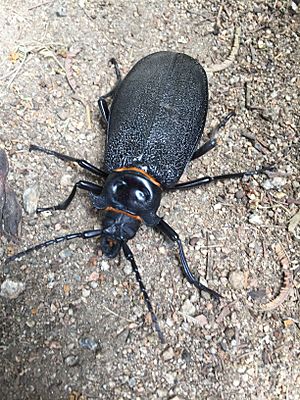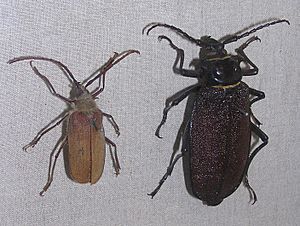Acanthinodera facts for kids
Quick facts for kids Acanthinodera |
|
|---|---|
 |
|
| Scientific classification | |
| Synonyms | |
|
List
|
Acanthinodera cumingii is a very large type of longhorned beetle. It belongs to a group of beetles called Cerambycidae. This amazing beetle is the biggest one found in Chile! It lives only in central Chile, from the IV Coquimbo Region all the way down to the IX La Araucanía Region. It's the only species in its group, which means it's quite unique.
Contents
Meet the Acanthinodera cumingii Beetle
This beetle is special because the males and females look very different. This is called sexual dimorphism. In fact, they look so different that scientists first thought they were two separate species!
Male vs. Female Beetles
- Males: They are about 5 to 6 centimeters long. They are light brown and have a furry body. Males are active at night (nocturnal) and can fly.
- Females: They are much bigger, usually 8 to 9 centimeters long. Some have even been found to be over 12 centimeters! Females are black and are active during the day (diurnal). They cannot fly.
Special Defenses
When these beetles feel scared, they can make a loud hissing sound. They do this by rubbing their back legs against their wing covers. Even though they move slowly and are not aggressive, they can give a strong bite if you bother them. Their legs are very powerful with big claws. This makes it hard to remove them from surfaces like tree bark, clothes, or even skin!
Where Do These Beetles Live?
The Acanthinodera cumingii beetle is found only in Chile. It lives from the southern part of the Coquimbo Region down to the Malleco Province in the Araucanía Region. You can find them from the coast all the way up to the Precordillera hills.
The Life of a Acanthinodera cumingii Beetle
Scientists haven't studied the life cycle of this beetle a lot yet. But we do know some cool things!
From Egg to Adult
- Female beetles lay more than 100 white eggs. These eggs look a bit like grains of rice.
- They lay their eggs in dry tree trunks and rotting plants.
- It can take up to six years for an egg to grow into an adult beetle. This depends on how much moisture there is and how much food is available.
- The young beetles, called larvae, can grow very big. They can reach up to 13 centimeters long! Because of their large size, people in Chile often call this insect "the mother of the snake" in Spanish.
Important Role in Nature
These beetles play a very important part in nature. Their larvae help break down dead wood. This helps keep forests healthy. The larvae have been found living in about 30 different kinds of trees. This includes both native Chilean trees and trees that were brought from other places, like Eucalyptus.
What Threats Do They Face?
Sometimes, animals like foxes might try to eat these beetles. However, the beetle's strong jaws, which it uses to chew wood, might help it defend itself.
Protecting the Acanthinodera cumingii
In Chile, these amazing beetles are at risk. Their homes are being destroyed because of logging (cutting down trees) and new buildings. Also, because they are so big, people sometimes catch and kill them. This makes the danger of them disappearing even worse. It's important to protect these unique creatures and their habitats!


